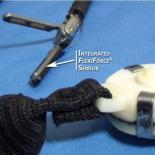FlexiForce™ Sensors Enhance Robotic Surgery
Due to advances in biomedical engineering, robotic surgery has become increasingly popular. One significant disadvantage of robotic surgery; however, is the lack of haptic technology and inability to provide force feedback to the surgeon. Because many medical devices and surgical tools such as grippers and laparoscopic instruments do not provide tactile sensation, there is no way for a Doctor to sense how much force is being applied when using the instrument during robotic surgery. The loss of tactile feedback limits the range of surgical techniques and affects the surgeon's dexterity.
Cambridge Research & Development (CRD), a pioneer in developing non-invasive, haptic man-machine interfaces that provide tactile force feedback, has recently completed research on a new haptic robotic interface to overcome this challenge. The interface, called the Neo, uses linear actuation to provide force feedback and mimics the sensation of force through a device that can be worn anywhere on the surgeon's body. A very sensitive and paper-thin FlexiForce™ sensor was placed in the front fenestration of a double fenestrated grasper. This sensor-enabled grasper is connected to the haptic interface worn by the surgeon. The force sensor can then measure applied force, which is read by the haptic interface and translated into pressure applied by the device through the use of a mechanism that moves up and down in response to force (See Image). The brain rapidly associates the pressure being applied by the Neo with sense of touch enabling the surgeon to adapt the use of force in response to pressure from the Neo. The integrated FlexiForce sensor is so small and thin, it is possible for the device to provide a full range of tactile sensation without having to increase the size of the instrument being used.
The robotics industry understands that the true potential of robotic and cybernetics lies in the ability of man and machine to meld...Full bio-compatibility is in our future but advancements have to be made now if we are truly going to realize the potential of our robotic counterparts. With this new haptic interface, we feel we are providing a solution which will lead to new and exciting capabilities from the surgery room to space.
-Ken Steinberg, CEO of Cambridge Research & Development
Benefits of FlexiForce Sensors
- Ultra-thin sensor construction and flexibility means minimal interference/disturbance to normal action
- Accurate response gives your customers and end users confidence in the performance of your product
- Knowledgeable, experienced technical staff help you develop the most effective, economical sensor based on your specific requirements. All manufacturing takes place at ISO 9001 compliant & 13485 registered Tekscan headquarters.
- 100% factory inspection ensures your sensors meet established performance specifications
Getting Started with FlexiForce Sensors
FlexiForce sensors are available off-the-shelf in packs of four or eight for testing and prototyping. Visit our online store to place an order, or contact us to discuss customization options with one of our engineers.


